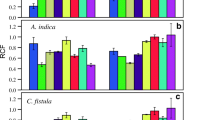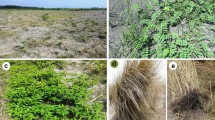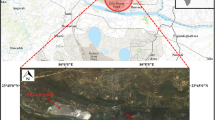Abstract
Discarding fly ash from a coal power plant into a dumpsite does not only contribute to deforestation and loss of productive land but also leads to contamination of air, soil, and groundwater. Therefore, fly ash should be managed properly to avoid the migration of contaminants. One management option is phytoremediation using adapted plants and as a prerequisite, there is a need to identify suitable plants that can be used for revegetation of fly ash dumpsites. To identify prospective plants, a survey was carried out by assessing the plants growing in Morupule B fly ash dumpsite based on their ability to accumulate heavy metals and their bioconcentration (BAF) and translocation factors (TF). Of the twenty-two-plant species growing in the fly ash dumpsite of Morupule B power plant station, N. glauca is a potential phytoextraction agent for Cu (TFCu = 1.02; BAFCu = 2.16) and Pb (TFPb = 1.38; BAFPb = 1.65); P. burchellii for Pb (TFPb = 1.61, BAFPb = 0.9) and Zn (TFZn = 1.35; BAFZn = 5.74); I. pes-tigridis for Pb (TFPb = 1.35; BAFPb = 1.56) and Zn (TFZn = 1.62; BAFZn = 7.43); A. pungens for Cr (TFCr = 1.22; BAFCr = 0.11), Cu (TFCu = 2.18; BAFCu = 1.14), and Zn (TFZn = 1.04; BAFZn = 1.44); E. hirta for Zn (TFZn = 1.54, BAFZn = 2.44); A. spinosus for Pb (TFPb = 1.29; BAFPb = 1.55); C. dactylon for Cu (TFCu = 1.86; BAFCu = 1.07) and Zn (TFZn = 1.00; BAFZn = 2.46); and D. aegyptium for Pb (TFPb = 1.19; BAFPb = 2.57). Other plants growing in the fly ash dumpsite are potential candidates for phytostabilization as they can tolerate a high concentration of metals and low essential nutrients. Also, different plant groups variably modified the pH, EC, OM, and exchangeable fractions of metals in the rhizosphere wherein grasses can increase the OM at higher rates, and it has a higher capacity to acidify and solubilize heavy metals in the rhizosphere leading to higher EC and available metals compared to other plant groups. Overall, the information presented is useful in identifying plants or their combinations for the phytoremediation of fly ash and other heavy metal-polluted environments.
Similar content being viewed by others
Data availability
All data generated or analyzed during this study are included in this published article.
References
Barazani Oz, Peramachi, S, Manandhar U, Vulkan R, Golan (Goldhirsh) A (2004) Heavy metal accumulation by Nicotiana glauca Graham in a solid waste disposal site. Chemosphere 54:867–872. https://doi.org/10.1016/j.chemosphere.2003.10.005
Bhatt A, Priyadarshini S, Acharath A, Abri A, Sattler M, Techapaphawit S (2019) Physical, chemical, and geotechnical properties of coal fly ash: a global review. Case Studies in Construction Materials 11:e00263. https://doi.org/10.1016/j.cscm.2019.e00263
Buscaroli A (2017) An overview of indexes to evaluate terrestrial plants for phytoremediation purposes (Review). Ecol Indic 82:367–380. https://doi.org/10.1016/j.ecolind.2017.07.003
Cameron KD, Teece MA, Smart LB (2006) Increased accumulation of cuticular wax and expression of lipid transfer protein in response to periodic drying events in leaves of tree tobacco. Plant Physiol 140:176–183. https://doi.org/10.1104/pp.105.069724
Chakraborty R, Mukherjee A (2010) Technical note: vetiver can grow on coal fly ash without DNA damage. Int J Phytoremediat 13:206–214. https://doi.org/10.1080/15226510903535171
Chehregani A, Malayeri BE (2007) Removal of heavy metals by native accumulator plants. Int J Agric Biol 9:462–465 http://www.fspublishers.org
Chinmayee D, Mahesh B, Pradesh S, Mini I, Swapna ST (2012) The assessment of phytoremediation potential of invasive weed Amaranthus spinosus L. Appl Biochem Biotechnol 167:1550–1559. https://doi.org/10.1007/s12010-012-9657-0
Clemens S (2001) Molecular mechanisms of plant metal tolerance and homeostasis. Planta 212:475–486. https://doi.org/10.1007/s004250000458
Dakora FD, Phillips DA (2002) Root exudates as mediators of mineral acquisition in low-nutrient environments. Plant Soil 245:35–47 https://link.springer.com/article/10.1023/A:1020809400075
Dwivedi A, Jain M (2015) Fly ash – waste management and overview: a review. Recent Res Sci Technol 6:30–35 https://www.semanticscholar.org/paper/Fly-ash-%E2%80%93-waste-management-and-overview-%3A-A-Review-Dwivedi-Jain/b275da81d97bbf4f038913d86c35189d955e2384
Estefan G, Sommer R, Ryan J (2013) Methods of soil, plant, and water analysis: a manual for the West Asia and North Africa region. Beirut, Lebanon. www.icarda.org
Fitz W, Wenzel W (2002) Arsenic transformations in the soil-rhizosphere-plant system: Fundamentals and potential application to phytoremediation. J Biotechnol 99:259–78. https://doi.org/10.1016/S0168-1656(02)00218-3
Gajić G, Djurdjević L, Kostić O, Jarić S, Mitrović M, Pavlović P (2018) Ecological potential of plants for phytoremediation and eco restoration of fly ash deposits and mine wastes. Front Environ Sci 6:1–24. https://doi.org/10.3389/fenvs.2018.00124
Gisbert C, Ros R, De Haro A, Walker D, Bernal M, Serrano R, Navarro-Aviñó J (2003) A plant genetically modified that accumulates Pb is especially promising for phytoremediation. Biochem Biophys Res Commun 303:440–445. https://doi.org/10.1016/S0006-291X(03)00349-8
González A, Tezara W, Rengifo E, Herrera A (2012) Ecophysiological responses to drought and salinity in the cosmopolitan invader Nicotiana glauca. Braz J Plant Physiol 24:213–222
Gupta DK, Rai UN, Tripathi RD, Inouhe M (2002) Impacts of fly-ash on soil and plant responses. J Plant Res 115(6):401–409
Hameed M, Ashraf M (2008) Physiological and biochemical adaptations of Cynodon dactylon (L.) Pers. from the salt range (Pakistan) to salinity stress. Flora 203:683–694. https://doi.org/10.1016/j.flora.2007.11.005
Hamzah A ,Hapsari R, Priyadarshini R (2017) The potential of wild vegetation species of Eleusine indica L., and Sonchus arvensis L. for phytoremediation of Cd-contaminated soil. Journal of Degraded and Mining Lands Management 04:797–805. https://doi.org/10.15243/jdmlm.2017.043.797
Hu L, Wang Z, Du H, Huang B (2010) Differential accumulation of dehydrins in response to water stress for hybrid and common bermudagrass genotypes differing in drought tolerance. J Plant Physiol 167:103–109 https://www.sciencedirect.com/science/article/pii/S0176161709003058?via%3Dihub
Irshad M, Ahmad S, Pervez A, Inoue M (2015) Phytoaccumulation of heavy metals in natural plants thriving on wastewater effluent at Hattar industrial estate. Pakistan. Int J Phytoremediation 17(1–6):154–8. https://doi.org/10.1080/15226514.2013.862208
Kabelo O (2018) Petrographic and geochemical characterization of part of a permian coal deposit of the South-Eastern Kalahari sub-basin, Moiyabana area, eastern Botswana. Dissertation, Botswana International University of Science and Technology
Kausel G (1991) Study of heavy metal tolerant flora in Botswana. Botswana Notes and Records 23:159–174
Keboletse K, Mongalenyane T, Kelebopile L, Oladijo P, Kutua S (2018) Investigating the suitability of Morupule coal for coal gasification technology. MRS Adv 3:2235–2245. https://doi.org/10.1557/adv.2018.442
Kumla J, Suwannarach N, Bussaban B, Matsui K, Lumyong S (2014) Indole-3-acetic acid production, solubilization of insoluble metal minerals and metal tolerance of some sclerodermatoid fungi collected from northern Thailand. Ann Microbiol 64:707–720. https://doi.org/10.1007/s13213-013-0706-x
Lai ZR, Liu JB, Zhang YQ, Wu B, Qin S, Sun Y, Zhang J, Feng W, Fa K, Bai Y (2017) Introducing a shrub species in a degraded steppe shifts fine root dynamics and soil organic carbon accumulations, in northwest China. Ecol Eng 100:277–285. https://doi.org/10.1016/j.ecoleng.2017.01.001
Li Z, Chen L, Liu S, Ma H, Wang L, An C, Zhang R (2016) Characterization of PAHs and PCBs in fly ashes of eighteen coal-fired power plants. Aerosol Air Qual Res 16:3175–3186. https://doi.org/10.4209/aaqr.2016.10.0430
Liao Z, Xiao X, Hu Y, Sun X, Wang H, Zhou H, Ma Y, Li J (2018) Toxic effects of coal fly ash on wheat seedlings. Environ Geochem Hlth 40:2371–2381 https://europepmc.org/article/med/29627928
Liphadzi MS, Kirkham MB (2005) Phytoremediation of soil contaminated with heavy metals: a technology for rehabilitation of the environment. S Afr J Bot 71:24–37. https://doi.org/10.1016/S0254-6299(15)30145-9
Mahar A, Wang P, Ali A, Awasthi MK, Lahori AH, Wang Q, Li R, Zhang Z (2016) Challenges and opportunities in the phytoremediation of heavy metals contaminated soils: a review. Ecotoxicol Environ Saf 126:111–121. https://doi.org/10.1016/j.ecoenv.2015.12.023
Maiti D, Pandey VC (2020) Metal remediation potential of naturally occurring plants growing on barren fly ash dumps. Environ Geochem Health. https://doi.org/10.1007/s10653-020-00679-z
Majsec K, Pavlica M (2014) Molecular mechanism of Cd accumulation in Nicotiana glauca. In: Plant Biology Europe FESPB/EPSO 2014 Congress. https://bib.irb.hr/datoteka/726535.Posters-Final-14-July-2014.pdf. Accessed 28 July 2020
Marschner H, Römheld V, Horst WJ, Martin P (1986) Root-induced changes in the rhizosphere: importance for the mineral nutrition of plants. J Plant Nutr Soil Sci 149:441–436. https://doi.org/10.1002/jpln.19861490408
Mellem JJ, Baijnath H, Odhav B (2009) Translocation and accumulation of Cr, Hg, As, Pb, Cu, and Ni by Amaranthus dubius (Amaranthaceae) from contaminated sites. J Environ Sci Health A 44:568–575. https://doi.org/10.1080/10934520902784583
Mganga N (2014) The potential of bioaccumulation and translocation of heavy metals in plant species growing around the tailing dam in Tanzania. Int J Sci 3:690–697 https://www.semanticscholar.org/paper/The-Potential-of-Bioaccumulation-andTranslocationMganga/8e9b8164d4ab6e200f3b8265a7ddabc8ebb53811
Montero E, Francisco AM, Montes E, Herrera A (2018) Salinity induction of recycling Crassulacean acid metabolism and salt tolerance in plants of Talinum triangulare. Ann Bot 121:1333–1342. https://doi.org/10.1093/aob/mcy030
Nawaz I, Ash F (2013) Disposal and utilization of fly ash to protect the environment. Int J Innov Res Sci Eng Technol 2:5259–5266 http://www.ijirset.com/upload/october/20_Disposal.pdf
Ogundele D, Adio A, Oludele OE (2015) Heavy metal concentrations in plants and soil along heavy traffic roads in North Central Nigeria. J Environ Anal Toxicol 05. https://doi.org/10.4172/2161-0525.1000334
Panda D, Barik JR, Barik J, Behera PK, Dash D (2020) Suitability of Brahmi (Bacopa monnieri L.) cultivation on fly ash-amended soil for better growth and oil content. Int J Phytoremediat. https://doi.org/10.1080/15226514.2020.1791052
Pandey VC (2012) Invasive species based efficient green technology for phytoremediation of fly ash deposits. J Geochem Explor 123:13–18 https://www.researchgate.net/publication/257189078_Invasive_species_based_efficient_green_technology_for_phytoremediation_of_fly_ash_deposits
Pandey VC (2015) Assisted phytoremediation of fly ash dumps through naturally colonized plants. Ecol Eng 82:1–5. https://doi.org/10.1016/j.ecoleng.2015.04.002
Pandey VC, Mishra T (2018) Assessment of Ziziphus mauritiana grown on fly ash dumps: Prospects for phytoremediation but concerns with the use of edible fruit. Int J Phytoremediation 20(12):1250–1256 https://www.tandfonline.com/doi/abs/10.1080/15226514.2016.1267703
Pandey KS, Bhattacharya T, Chakraborty S (2016) Metal phytoremediation potential of naturally growing plants on fly ash dumpsite of Patratu thermal power station, Jharkhand, India. Int J Phytoremediat 18:87–93. https://doi.org/10.1080/15226514.2015.1064353
Pandey VC, Sahu N, Singh DP (2020) Physiological profiling of invasive plant species for ecological restoration of fly ash deposits. Urban For Urban Green 54:126773. https://doi.org/10.1016/j.ufug.2020.126773
Peng W, Wagner F, Ramana MV, Zhai H, Small MJ, Dalin C, Zhang X, Mauzerall DL (2018) Managing China’s coal power plants to address multiple environmental objectives. Nat Sustain 1:693–701. https://doi.org/10.1038/s41893-018-0174-1
Podlešáková E, Němeček J, Vácha R (2002) Critical values of trace elements in soils from the viewpoint of the transfer pathway soil - Plant. Rostlinna Vyroba 48:193–202. https://doi.org/10.17221/4224-PSE
Puzon JJ, Tabayoyong ER, Jumawan HJM (2015) Morpho-physiological changes in Euphorbia hirta L. in response to mercury exposure. Philipp J Sci 144:161–170 https://www.researchgate.net/publication/305349709
Rawat KS, Kumar R, Singh SK (2018) Topographical distribution of cobalt in different agro-climatic zones of Jharkhand state, India. Geol Ecol Landsc 3:14–21. https://doi.org/10.1080/24749508.2018.1481654
Savic D, Nisic D, Malic N, Dragosavljevic Z (2018) Research on power plant ash impact on the quality of soil in Kostolac and Gacko coal basins. Minerals 8:1–16. https://doi.org/10.3390/min8020054
Setshogo MP (2005) Preliminary checklist of plants of Botswana: Southern African Botanical Diversity Network Report No. 37. SABONET, Pretoria, and Gaborone. https://www.sanbi.org/wp-content/uploads/2018/04/sabonet-report-no-37-preliminary-checklist-plants-botswana.pdf. Accessed 20 Apr 2020
Shah A, Niaz A, Ullah N, Rehman A, Akhlaq M, Zakir M, Khan M (2013) Comparative study of heavy metals in soil and selected medicinal plants. J Chem 2013:1–5. https://doi.org/10.1155/2013/621265
Shi H, Wang Y, Cheng Z, Ye T, Chan Z (2012) Analysis of natural variation in bermudagrass (Cynodon dactylon) reveals physiological responses underlying drought tolerance. PLoS ONE 7(12):e53422. https://doi.org/10.1371/journal.pone.0053422
Shu WS, Zhao YL, Yang B, Xia HP, Lan CY (2004) Accumulation of heavy metals in four grasses grown on lead and zinc mine tailings. Int J Environ Sci 1 6:730–734 https://www.researchgate.net/publication/8167134_Accumulation_of_heavy_metals_in_four_grasses_grown_on_lead_and_zinc_mine_tailings
Singh R, Singh DP, Kumar N, Bhargava SK, Barman SC (2010) Accumulation and translocation of heavy metals in soil and plant from fly ash contaminated area. J Environ Biol 31:421–430 https://www.researchgate.net/publication/49710240_Accumulation_and_translocation_of_heavy_metals_in_soil_and_plants_from_fly_ash_contaminated_area/citation/download
Singh A, Prasad SM, Singh S, Singh M (2016) Phytoremediation potential of weed plants’ oxidative biomarker and antioxidant responses. Chem Ecol 32:684–706. https://doi.org/10.1080/02757540.2016.1182994
Sun X, Li Z, Wu L, Christie P, Luo Y, Fornara DA (2019) Root-induced soil acidification and cadmium mobilization in the rhizosphere of Sedum plumbizincicola: evidence from a high-resolution imaging study. Plant Soil 436(1-2):267–282. https://doi.org/10.1007/s11104-018-03930-w
Tyler G, Olssen T (2001) Plant uptake of major and minor mineral elements as influenced by soil acidity and liming. Plant Soil 230:307–321. https://doi.org/10.1023/A:101031440097
Ultra VU, Manyiwa T( 2020) Influence of mycorrhiza and fly ash on the survival, growth and heavy metal accumulation in three Acacia species grown in Cu–Ni mine soil. Environ Geochem Health. https://doi.org/10.1007/s10653-020-00627-x
Ultra VU, Han SH (2015) Elevated atmospheric temperature and CO2 altered the growth, carbon, and nitrogen distribution and the rhizosphere properties of Platanus occidentalis L. seedlings. Turk J Agric For 39:679–691 http://journals.tubitak.gov.tr/agriculture/
Ultra VU, Nunez JP, Lee SC (2016) Influence of charcoal-based soil amendments on growth and nutrient uptake of rice (Oryza sativa) in Cadmium contaminated soil. Emirates J Food Agric 28(12):872–881. https://doi.org/10.9755/ejfa.2016-05-574
Verma SK, Singh K, Gupta AK, Pandey VC, Trivedi P, Verma RK, Patra DD (2014) Aromatic grasses for phytomanagement of coal fly ash hazards. Ecol Eng 73:425–428
Vodyanitskii Y (2016) Standards for the contents of heavy metals in soils of some states. Ann Agrar Sci 14:257–263 https://www.sciencedirect.com/science/article/pii/S1512188716300665
Walkley A, Black IA (1934) An examination of Degtjareff method for determining soil organic matter and a proposed modification of the chromic acid titration method. Soil Sci. 37:29–37. https://doi.org/10.1097/00010694-193401000-00003
Wang W, Ling Q, Yuan-Gang Z, Dong-Xue S, Jing A, Hong-Yan W et al (2011) Changes in soil organic carbon, nitrogen, pH and bulk density with the development of larch (Larix gmelinii) plantations in China. Glob Chang Biol 17:2657–2676. https://doi.org/10.1111/j.1365-2486.2011.02447.x
Yadav SK (2010) Heavy metals toxicity in Plants: an overview on the role of glutathione and phytochelatins in heavy metal stress tolerance of plants. S Afr J Bot 76:167–179. https://doi.org/10.1016/j.sajb.2009.10.007
Yan L, Xinrong L, Mingzhu H, Fanjiang Z (2013) Behavior of native species Arrhenatherum Elatius (Poaceae) and Sonchus Transcaspicus (Asteraceae) exposed to a heavy metal polluted field: Plant Metal Concentration, Phytotoxicity, and Detoxification Responses. Int J Phytoremediat 15:924–937. https://doi.org/10.1080/15226514.2012.735288
Zhai M, Totolo O, Modisi MP, Finkelman RB, Kelesitse SM, Menyatso M (2009) Heavy metal distribution in soils near Palapye, Botswana: an evaluation of the environmental impact of coal mining and combustion on soils in a semi-arid region. Environ Geochem Hlth 31:759–777. https://doi.org/10.1007/s10653-009-9260-7
Zhao Y, Du H, Wang Z, Huang B (2011) Identification of proteins associated with water-deficit tolerance in C4 perennial grass species, Cynodon dactylon × Cynodon transvaalensis and Cynodon dactylon. Physiol Plant 141:40–55 https://www.researchgate.net/deref/http://dx.doi.org/10.1111/j.1399-3054.2010.01419.x
Zhou J, Xue K, Xie J, Deng Y, Wu L, Cheng X, Fei S, Deng S, He Z, van Nostrand JD, Luo Y (2012) Microbial mediation of carbon-cycle feedbacks to climate warming. Nat Clim Chang 2:106–110. https://doi.org/10.1038/nclimate1331
Zoysa AKN, Loganathan P, Hedley MJ (1998) Phosphate rock dissolution and transformation in the rhizosphereof tea (Camellia sinensisL.) compared with other species. Eur J Soil Sci 49:477–486. https://doi.org/10.1046/j.1365-2389.1998.4930477.x
Funding
This paper is supported by BIUST Initiation Grant (REF.: DVC/RDI/2/1/3/XI (66) to VUU and BIUST Graduate Research Grant (REF: DVC/RDI/2/1/7 V (22) to KG.
Author information
Authors and Affiliations
Contributions
All the authors listed in this manuscript have contributed to the study conception and design, material preparation, and data collection; and analysis were performed by Pearl Wathuto David, Katumelo Gajaje, and Dr. Venecio U. Ultra Jr. Plants specimen were identified and classified by Dr. Gaolathe Rantong.
Corresponding author
Ethics declarations
We declared that this manuscript is our original research and has full compliance with the ethical standard. Necessary permits and consent were obtained for sample acquisition of the study site, adhered to the requirements of the funding institution and this has not been submitted or considered for publication elsewhere in any form or language (partially or in full).
Conflict of interest
The authors declare that they have no conflict of interest.
Human and animal rights
This study does not involve any human and animal subjects.
Ethical approval
This manuscript did not involve any human participants, human data, human tissues, or cloned animals hence ethical approval not applicable.
Consent to participate
Not applicable
Consent to publish
All authors have full consent to publish the content of the manuscript.
Additional information
Responsible Editor: Elena Maestri
Publisher’s note
Springer Nature remains neutral with regard to jurisdictional claims in published maps and institutional affiliations.
Rights and permissions
About this article
Cite this article
Gajaje, K., Ultra, V.U., David, P.W. et al. Rhizosphere properties and heavy metal accumulation of plants growing in the fly ash dumpsite, Morupule power plant, Botswana. Environ Sci Pollut Res 28, 20637–20649 (2021). https://doi.org/10.1007/s11356-020-11905-7
Received:
Accepted:
Published:
Issue Date:
DOI: https://doi.org/10.1007/s11356-020-11905-7




